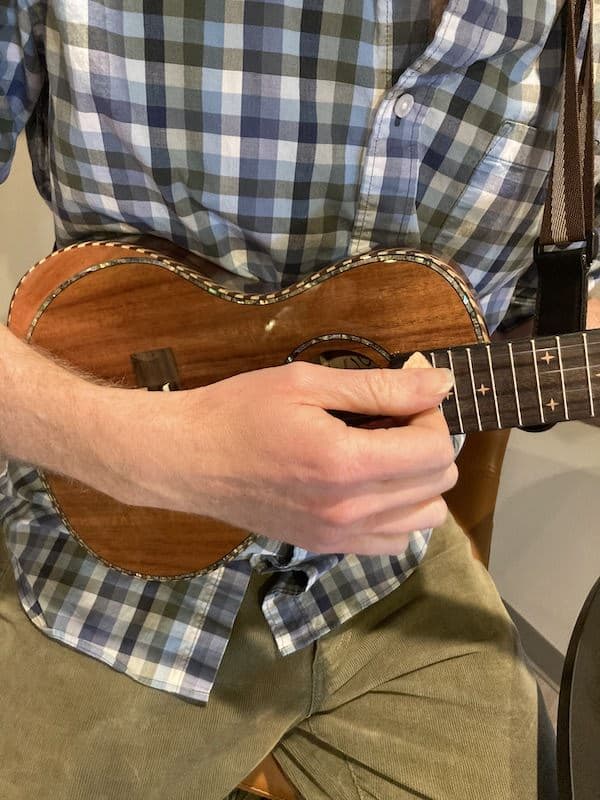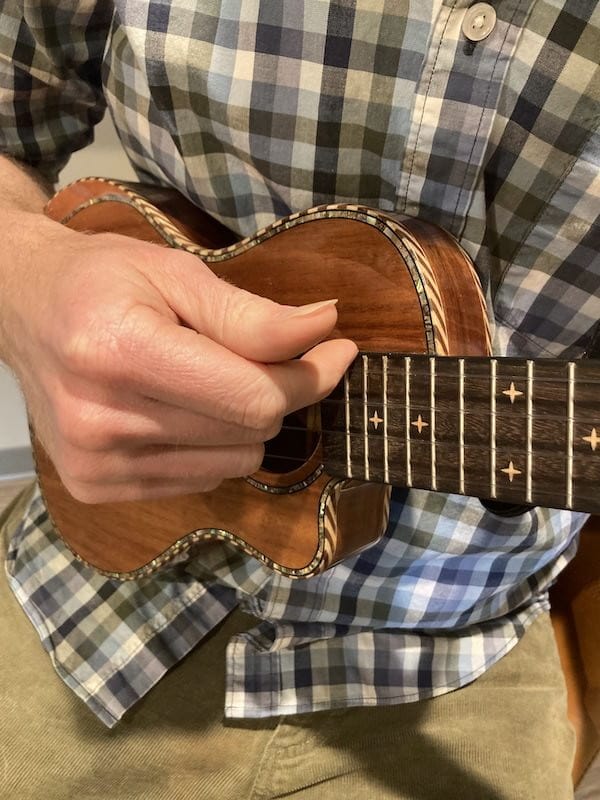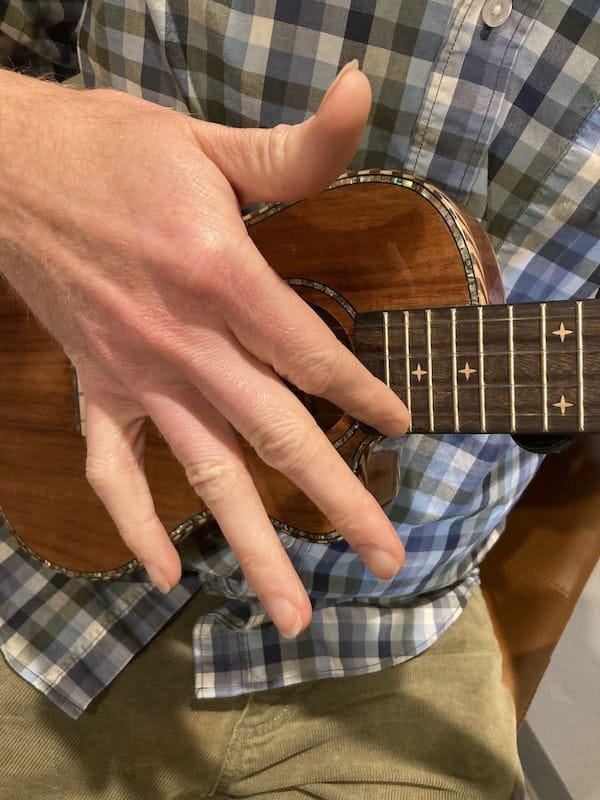This article will explore how I came to learn how to strum a ukulele and many tips you can use when learning how to improve your own ukulele strumming.
Written by John Allnutt / Published May 23, 2024
Last updated: N/A

One of my many attractions to the humble ukulele is how tactile and intimate it can be while playing one. The most common way to strum is by using your fingers on your strumming hand. Exploring exactly HOW you do that and its many possibilities is probably what drew me in immediately to the ukulele.
This article will explore how I discovered some common strumming practices through trial and error and how you can best get started trying out these strumming techniques yourself.
Getting Started with Strumming the Ukulele
When I began learning the ukulele I first just experimented with what felt most natural to me at the time and approached strumming a ukulele just with my thumb first. This seemed like the most logical place to begin because it reminded me of using a guitar pick. I had some experience with guitar many years before first picking up the ukulele.

Tip No. 1 – Using a Ukulele Pick
A soft pick can be used on the ukulele but is not very common in the ukulele community at the time of this writing. However, a notable player of the felt pick was Lyle Ritz with his fantastic album “How About Uke?”. Lyle’s style and influence pioneered jazz ukulele playing back in the 1950’s.
At first, I really enjoyed strumming the ukulele with my thumb and after reading and watching how Sir Paul McCartney played bass, with his thumb. In playing this way, I felt very comfortable in my stance about how I approached the ukulele.
About a week later, I had accumulated many hours of playtime on my first ukulele and noticed that my thumb was taking some serious abuse with the skin getting raw and blistered. My next foray into strumming would be to begin using the index (or pointer) finger.

Tip No. 2 – “Rule of Thumb”
Strumming with your thumb provides a very warm sound and can be performed delicately or loudly depending on how much pressure you apply. The thumb also does a fantastic job at picking melodies on the ukulele because of its ability to make a warm singing sound. The only thing that the thumb lacks (unless you have a very long thumbnail) is brightness of sound or articulation. Make sure to get the full amount of sound out of your ukulele without overplaying and be sure to strum all of the strings following through with your strumming stroke.
Using the Index Finger to Strum a Ukulele
After my first exciting week behind the ukulele my thumb was a bit sore and I could kick myself for not looking into taking up the ukulele sooner. The guitar is a great instrument but perhaps the ukulele would have been a lot better instrument to start with many, many years ago before taking up the guitar.
With its ease of learning, less string tension, and many other factors – I questioned why the ukulele had not been a MUCH more popular stringed instrument. Tangents aside, I continued my ukulele Google rabbit-hole into “How to Strum the Ukulele”.
After some research, I found that most people strummed the ukulele with their index or pointer finger. This is generally performed by pointing at yourself above the strings then strumming through the strings with your pointer finger aimed at the floor making contact with the fingernail and strings.


This was a very different approach than I was used to and took some time to get comfortable with.
Initially, what I liked about it so much was the sound was very akin to the guitar pick I was used to with guitar. It also allowed me to strum a bit faster because the pointer finger is smaller than the thumb and the nail could move faster through the strings than the skin on the thumb.


Tip No. 3 – That’s the Point…
When you strum with the pointer finger, you contact the strings with your nail first, then the soft skin on the way up. This allows you to make brighter, more articulate sounds on strong beats and softer sounds on the offbeats. Alternatively, when strumming with the thumb you get a soft and warm sound on the way down through the strings and a bright sound on the way up due to the nail.
When strumming, make sure that you strum the strings where the ukulele neck overlaps with the body. This position is generally regarded as the ukulele’s sweet spot. Also, try experimenting with strumming other areas of the ukulele. That will include the fingerboard and all the way down by the bridge taking notes on the sound differences you hear.
What About Ukulele Fingerpicking?
After playing songs that have simple strums you may discover songs that feature fingerpicking and more intricate strumming handiwork. Fingerpicking is a fascinating alternative to the strumming suggestions mentioned above.
Fingerpicking involves the thumb and the other fingers either working either simultaneously or independently whereas strumming usually involves playing three or four strings in a rake-like motion.
Tip No. 4 – Fingerpicking
Explore songs that feature these techniques and use of the thumb for either melody or bass accompaniment in songs. Check out this article for more information about ukulele fingerpicking.
More Advanced Techniques for Strumming a Ukulele
When the above techniques become easier with practice and you are looking to up your ukulele game, try strumming the uke downward with your thumb and upwards with your pointer finger.
D = Down, U = Up D U D U D U D U
This will produce a soft sound as the strings will only be in contact with your skin. It will also sound similar to “boom chick” especially if using a ukulele with a low G string. This picking technique could be used to play songs by Johnny Cash. Such as Ring of Fire or Folsom Prison Blues.
Next, try the same pattern listed directly above, but this time lead with the pointer finger, then your thumb. This will give you a brighter sound as you will be making contact only with the nail of your pointer finger and thumb.
Conclusion
In conclusion, it is important to remember that no one pattern is “better” than the other. You may find that a certain pattern may work best for how you will serve the music; what style of music you are playing, how it lines up with the vocal part of a song, or how the rhythm of your strumming lines up with other musicians you are playing with.
Learn to be flexible and open to new rhythms and patterns!
Lastly, try creating your own strumming patterns. This article is just a start to the possibilities of strumming a ukulele!

John Allnutt
Writer & Ukulele TeacherJohn has been teaching music since 2008 and resides in Richmond, Kentucky with his wife Laura and dog Sam. In his spare time he enjoys growing and cooking food, roasting coffee, playing board games, and spreading joy through playing and teaching music.




